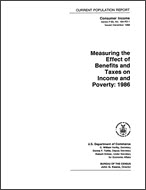Measuring the Effect of Benefits and Taxes on Income and Poverty: 1986
Measuring the Effect of Benefits and Taxes on Income and Poverty: 1986
Introduction
This is the first of a series of experimental reports to be released with a P-60-RD designation. This new series will bring together the benefit and tax data that have previously appeared in separate reports. This report presents experimental data showing the effect of taxes and transfers on the distribution of income and the prevalence of poverty. It was prepared by using statistical techniques and models to estimate amounts of taxes paid and the income value of food stamps, school lunch subsidies, rent subsidies, Medicare coverage, Medicaid coverage, employer contributions to employee health plans, and home equity. (Appendixes B and C explain the methodology.) The estimates of the income value of noncash benefits are based on specific assumptions and models and may change as additional research results and more current data sources become available.
The report shows the distribution of income among households and the prevalence of poverty under the official definition (money income excluding capital gains before taxes) and under definitions that add income components or subtract taxes. For example, the 1986 median income of U.S. households was $24,897 (± $206)1 under the official definition but dropped to $22,745 (± $237) when government transfers were excluded from the income definition. The median rose to $24,211 (± $242) when capital gains and the value of employer contributions to employee health plans were added to the definition, then declined to $20,180 (± $186) when income and payroll taxes, were deducted. By adding in the various government transfer components, the median was brought to $23,220 (± $160), and adding in the final component, net imputed return on home equity, brought the median to $24,984 (± $170). The official poverty rate for persons was 13.6 (± .3) percent in 1986, and the rate rose to 20.8 (± .4) percent when government transfers were excluded from the income definition. Adding in capital gains and employer health benefits brought the poverty rate to 19.9 (± .4) percent, but deducting income and payroll taxes increased the rate to 21.2 (± .4) percent. Nonmeans-tested government cash transfers were added, bringing the poverty rate down to 14.9 (± .4) percent, and adding in the other components of government transfers resulted in a rate of 11.6 (± .3) percent.
The income distribution research on which the report is based was performed at the Bureau of the Census during the past several years and included comments received from data users. A number of recommendations were offered by participants in the Census Bureau's 1985 Conference on the Measurement of Noncash Benefits,2 and those recommendations received careful consideration during the development of the estimation methods used in this report. Data in this report are for calendar year 1986. It was not possible to produce estimates for 1987 because the data that are required to estimate income taxes were not available at the time this report was prepared.
In the recent past, the Bureau of the Census has published a number of technical papers that presented experimental poverty estimates based on income definitions that counted the value of selected government noncash benefits. The Census Bureau has also published annual reports on after-tax income.
The Census Bureau will continue to publish annual official statistics on income and poverty, and for purposes of comparison, the tables in this report show official as well as experimental estimates. The official series on the distribution of income began in 1947, and estimates of the number and percentage of persons in poverty are available from 1959 to the present (1987). Annual income and poverty estimates are based on data collected each March in a supplement to the Current Population Survey (CPS).
The growth in government programs such as food stamps, Medicaid, and Medicare, and the private sector growth in employer contributions to health plans focused attention on the issue of whether currently available data on the distribution of income and the prevalence of poverty were based on an income definition that was sufficiently comprehensive.
__________
1 The figures in parentheses denote the 90-percent confidence interval of the estimate.
2 The Census Bureau sponsored this conference in December 1985. Its proceedings have been published in Conference on the Measurement of Noncash Benefits.
A Note on Language
Census statistics date back to 1790 and reflect the growth and change of the United States. Past census reports contain some terms that today’s readers may consider obsolete and inappropriate. As part of our goal to be open and transparent with the public, we are improving access to all Census Bureau original publications and statistics, which serve as a guide to the nation's history.
Others in Series
Publication
Publication
Publication




